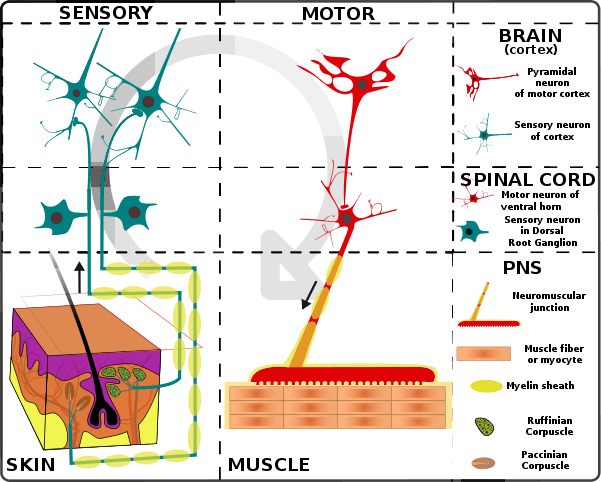Afferent nerve fiber
| Afferent nerve fiber | |
|---|---|
.png) | |
| Details | |
| System | Nervous system |
| Identifiers | |
| Latin | neurofibrae afferentes |
| TA | A14.2.00.017 |
| TH | H2.00.06.1.00015 |
| FMA | 76570 |
| Anatomical terms of neuroanatomy | |
Afferent nerve fibers refer to axonal projections that arrive at a particular region; as opposed to efferent projections that exit the region. These terms have a slightly different meaning in the context of the peripheral nervous system (PNS) and central nervous system (CNS).
In the PNS, afferent and efferent projections are always from the perspective of the spinal cord (see figures). PNS afferents are the axons of sensory neurons carrying sensory information from all over the body, into the spine. PNS efferents are the axons of spinal cord motor neurons that carry motor-movement signals out of the spine to the muscles.[1][2][3]
In the CNS, afferent and efferent projections can be from the perspective of any given brain region. That is, each brain region has its own unique set of afferent and efferent projections. In the context of a given brain region, afferents are arriving fibers while efferents are exiting fibers.
Structure

Afferent neurons' somas are located in the ganglia of the peripheral nervous system, and the axons of these cells travel from ganglion to ganglion and lead back to the spinal cord. The majority of these are unipolar neurons in that they have a single axon leaving the cell body and is sent towards the sensory organ.[4] All of the axons in the dorsal root, which contains afferent nerve fibers, are used in the transduction of somatosensory information. Somatosensory receptors include senses such as pain, touch, temperature, itch, and stretch. For example, a specific muscle fiber called an intrafusal muscle fiber is a type of afferent neuron that lies parallel to the extrafusal muscle fibers thus functions as a stretch receptor by detecting muscle length.[4] All of these sensations travel along the same general pathway towards the brain. From the dorsal root ganglion they travel to the spinal cord.[4] From the spinal cord to the medulla, which then leads to the medial lemniscus of the midbrain. From here it travels to the primary somatosensory cortex of the parietal lobe.
Types
Types of afferent fibers include the general somatic (GSA), the general visceral (GVA), the special somatic (SSA) and the special visceral afferent fibers (SVA).
| Type | Primary/secondary | Response |
| Type Ia | primary | Respond to the rate of change in muscle length, as well to change in velocity, rapidly adapting |
| Type Ib | N/A | In Golgi tendon organ, responds to muscle tension changes |
| Type II | secondary | Provide position sense of a still muscle, fire when muscle is static [5] |
Function
In the nervous system there is a "closed loop" system of sensation, decision, and reactions. This process is carried out through the activity of sensory neurons, interneurons, and motor neurons.
A touch or painful stimulus, for example, creates a sensation in the brain only after information about the stimulus travels there via afferent nerve pathways. Afferent neurons are pseudounipolar neurons that have a single long axon with a short central and a long peripheral branch. These cells do not have dendrites.[6] They have a smooth and rounded cell body. Just outside the spinal cord, thousands of afferent neuronal cell bodies are aggregated in a swelling in the dorsal root known as the dorsal root ganglion.[4][6]
Etymology and mnemonics
Afferent is derived from Latin participle afferentem (af- = ad- : to + ferre : bear, carry), meaning carrying into. Ad and ex give an easy mnemonic device for remembering the relationship between afferent and efferent : afferent connection arrives and an efferent connection exits.[7]
Another mnemonic device used for remembering afferent and efferent (in terms of the spinal cord, with its dorsal/ventral organization) is SAME DAVE. Sensory Afferent Motor Efferent, Dorsal Afferent Ventral Efferent.
Afferent and efferent are connected to affect and effect through their common Latin roots: Afferent nerves affect the subject, whereas efferent nerves allow the subject to effect change.
See also
References
- ↑ Mader S. S. (2000): Human biology. McGraw-Hill, New York, ISBN 0-07-290584-0; ISBN 0-07-117940-2.
- ↑ Hall J. E., Guyton A. C. (2006): Textbook of medical physiology, 11th edition. Elsevier Saunders, St. Louis, Mo, ISBN 0-7216-0240-1.
- ↑ Warrell D. A., Cox T. M., Firth J. D. (2010): The Oxford Textbook of Medicine Archived 2012-03-21 at the Wayback Machine. (5th ed.). Oxford University Press
- 1 2 3 4 Carlson, Neil. Physiology of Behavior. Upper Saddle River, New Jersey: Pearson Education, Inc. ISBN 9780205239399.
- ↑ Michael-Titus, Adina T (2007). Nervous System: Systems of the Body Series. Churchill Livingstone. ISBN 9780443071799.
- 1 2 MacCallum, Don. "Peripheral Nervous System". Histology and Virtual Microscopy Learning Resources. University of Michigan Medical School. Archived from the original on 2014-07-07. Retrieved 24 June 2014.
- ↑ MedicalMnemonics.com: 3502 3463 367 115